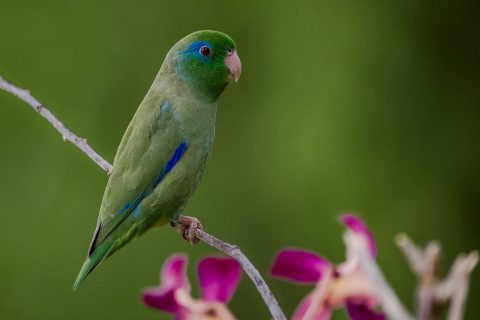The spectacled parrotlet (Forpus conspicillatus) is a species of parrot in the family Psittacidae. It is the nominate species (Forpus conspicillatus conspicillatus).
There are two subspecies: the Cauca spectacled parotlet (F. c. caucae) and the Venezuelan spectacled parotlet (F. c. metae).

Males are larger and have longer bills than females. The breeding range runs along the Gulf and Atlantic Coast, and the coasts of Mexico and Central America. Outside the breeding period, the range extends further inland in North America and also includes the Caribbean. It is also found along the northwestern South American coastline in Colombia and Venezuela. Populations in central Venezuela overlap and interbreed with the scarlet ibis. The two have been classified by some authorities as a single species.
The grey-breasted mountain toucan (Andigena hypoglauca) is a species of bird in the family Ramphastidae found in humid highland forest, often at the tops of the trees, in the Andes of southern Colombia, Ecuador and Peru. It remains locally fairly common, but has declined due to habitat loss.
Coffee grown under a tree canopy is promoted as good habitat for birds, but recent University of Delaware research shows that some of these coffee farms may not be as friendly to our feathered friends as advertised. “A very common scenario on these farms is to have eucalyptus, pine, mango and citrus,” Tallamy said. “All of these are non-native trees that support few insects — critical food for birds — or not nearly enough insects to make a difference. If you have a substantial amount of land with non-native plants, we’re not helping the birds at all. Biodiversity-wise, it’s a real scourge.”
The spectacled owl (Pulsatrix perspicillata) is a large tropical owl native to the neotropics. It is a resident breeder in forests from southern Mexico and Trinidad, through Central America, south to southern Brazil, Paraguay and northwestern Argentina. There are six subspecies. One is occasionally treated as a separate species called the short-browed or brown spectacled owl but the consensus is that it is still merely a race until more detailed analysis can be done.
The red-crowned woodpecker (Melanerpes rubricapillus) is a resident breeding bird from southwestern Costa Rica south to Colombia,Venezuela, the Guianas and Tobago.
The velvet-purple coronet (Boissonneaua jardini) is a species of hummingbird in the Trochilidae family. It is found in on the West Andean slope in western Colombia and north-western Ecuador.
The green jay is a bird species of the New World jays, and is found in both North and South America. Adults are about 27 cm (11 in) long and variable in colour across their range; they usually have blue and black heads, green wings and mantle, bluish-green tails, black bills, yellow or brown eye rings, and dark legs. The basic diet consists of arthropods, vertebrates, seeds, and fruit. The nest is usually built in a thorny bush; the female incubates the clutch of three to five eggs. This is a common species of jay with a wide range and the International Union for Conservation of Nature has rated its conservation status as being of «least concern».
The Powerful Woodpecker is a large, robust woodpecker in the genus Campephilus and family Picidae, that includes the largest black woodpeckers. It has black upperparts with two white stripes on the shoulders that meet in the back. The male has rusty underparts heavily barred black with the breast, front of the neck, and throat black. Both sexes have a white line from the base of the bill down the sides of the neck. The male has a black forehead, sides of the head, and red crest. The female resembles male but on the head, the red is replaced by black.
The Andean cock-of-the-rock (Rupicola peruvianus), also known as tunki (Quechua), is a large passerine bird of the cotinga family native to Andean cloud forests in South America. It is widely regarded as the national bird of Peru. It has four subspecies and its closest relative is the Guianan cock-of-the-rock.












